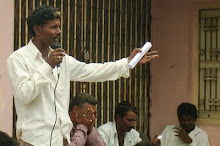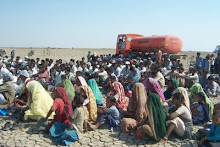Scorching salt
RAVLEEN KAUR
The earth is cracked and the horizon bare. The deathly silence is broken by the occasional whirring of crude-oil pumps. Women, going about their daily life in bright mirror-work lehangas, add a dash of colour to an otherwise arid background. This tough terrain has dominated 50-year-old Shantabhai Maganbhai Bamania's life since he was 10.Shantabhai is an Agaria, a salt worker. The Rann of Kutch in Gujarat is his home to him and his family for eight months a year, from September to April. The remaining four months they spend in Kharagoda. Not just Shantabhai, the Rann of Kutch is home to more than 100,000 workers like him for eight months a year, who come from villages 30 to 40 kms away.Their livelihood has been under threat ever since the Little Rann of Kutch (the Rann is divided into the Little Rann and the Great Rann) was notified as a wildlife sanctuary in 1973 to protect the wild ass. In 2006, the salt workers were served eviction notices.The saltmaking Agarias do not understand why they are being asked to go, leaving behind an occupation they have been involved in for centuries. Where is the conflict, they ask. According to a Gujarat forest department sponsored study conducted by the Gujarat Ecological Education and Research Foundation (GEER), Ecological Study of the Wild Ass Sanctuary, the total area leased out for salt pans in 1995 was 13,357 ha, about three per cent of the sanctuary. The report notes that the area under salt production went up from 6,948 hectares (ha) in 1982-84 to 13,357 ha in 1995. At the same time, the wild ass population also went up from 720 in a 1976 census to 3863 in 2004. The report says "a minimum population of about 2,500 wild asses in the area would be a safe level to achieve the objective of conservation." "So where then is the conflict?" asks Harinesh Pandya, secretary of Agaria Heetrakshak Manch (AHRM), a forum that fights for the rights of Agarias. "The animals can often be found drinking water from the Agaria tanks. Never has a salt worker harmed a wild ass," says he. The forest department agrees there has been a healthy increase in the wild ass population of the area. It ascribes the rise in the number of wild asses to good rainfall in the past six years. "Wild ass mating gets disturbed by movement of salt trucks," says M A Chawda, Divisional Forest Officer of Dhrangadra. This is a classic case of speaking through the hat. Mating and breeding of wild asses begin in April and extends up to October. Trucks move into the area only in March and April when the salt harvest is ready. "The GEER report also suggests that there is no threat to wildlife from salt making. It only recommends the administration designate paths for trucks. It is a management problem, not an ecological one. Why punish Agarias if the government has not acted on this recommendation?" asks Vinay Mahajan of the Ahmedabad-based independent research institute, Sandarbh Development Studies. The government clearly follows a dual policy: act tough with the poor and be soft towards the powerful. It wants the Agarias to vacate the three per cent sanctuary area used for salt production. On the other hand, proposals for an oil and gas pipeline, from Oil and Natural Gas Commission and Cairn Energy, are now with the government for consideration. This pipeline, if approved, will pass through the Little Rann. The Narmada canal, which too will pass through the sanctuary, has already been given the go-ahead. The Agarias' vulnerability stems from the fact that they have no land deeds. No survey has ever taken place in the Little Rann of Kutch since independence; it does not figure in government revenue records. Revenue department records in fact refer to the area as Survey Number Zero.The forest department often asserts that Agarias have no document to prove their claim over the Rann. But Pandya contends, "There is mention in documents of the colonial state of salt extraction in the Rann of Kutch." His organisation has recently ferreted evidence from Mughal times that shows that salt-making in the Rann dates back to more than five centuries. The government started making some moves to settle Agarias' land claims in 1997. Surendranagar's district collector issued a notice to Agarias to claim their entitlements in the sanctuary within two months. But the notice was sent in September when Agarias had left for the Rann, so they could not file claims. "The additional collector's office told us that it has received only 1,776 claims so far. But according to the Gujarat industries department report of 2006, more than 45,000 families are engaged in salt making in the sanctuary. How come only 1,776 claims were filed?" asks Pandya. In December 2006, AHRM organised a meeting following which 4,800 Agarias filed their claims till June 2007. During monsoon, water from the Arabian Sea floods the Rann converting it into a lake. In September, when the waters recede, it's time for Agarias from the 107 villages around the Little Rann to move in. Mud huts come up in Survey Number Zero, where Agarias stay till spring, making the Vadagara variety of salt - it has big crystals and is considered inferior to the powdered marine salt sold in most of urban India. Vadagara is made from sub-soil brine. Agarias dig a six to nine metre-deep well from where the brine is pumped out. This is then taken through channels to large flat pans. Getting these pans ready to receive the brine is tough work. Agarias stamp hard and level the earth with their bare feet. The pressure tightly packs the loose soil and ensures the brine does not seep back. "The initial layer of salt that is formed, once the brine evaporates, is scraped with heavy wooden rakes, locally known as gantaras. Some dry branches are thrown in, around which salt crystals form," says Shantabhai. Once the salt has been harvested it is sent to collection points.Here traders take over. These collection points are by the nearest railway station; in Shantabhai's case the salt harvest is despatched to Kharagoda railway station. "The trader usually gives us a monthly advance of Rs 12,000 to Rs 14,000. This includes expenses for crude oil and spare parts, which go up to Rs 12,000. The rest of the money goes in buying food," says Mahesh Godhabhai Gohil, an Agaria. "We come to the Rann with an advance and leave the place in debt," says he. Not just debts, Agarias also leave with scars and blisters on their hands. Uninterrupted exposure to the sun causes eye and skin problems. Stamping hard on the salt pans with bare feet leaves Agarias with blisters - it is only recently that some NGOs have started providing them with gumboots. Wounds take a long time to heal because they are constantly rubbed with salt. About 1 million tonnes of salt is produced in a year in the region. It is sent to UP, MP, Chhattisgarh and Nepal. For every 100 kg of salt, the trader gives Rs 15 to the Agaria - seven paise per kg. Traders sell the salt at Rs 45 to Rs 60 per 100 kg - they spend about Rs 35 on cartage and iodination. Not just poor payment, declining groundwater has become a problem for the Agarias as well. "Salt pans were active upped April 2007. But this year, they had to be wound up in March because of very little groundwater. The average production from each pan was 1,000 tonnes about 10 year's back. It is no more than 700 to 800 tonnes now," says Devibhai Dhamecha, naturalist and photographer, who also runs a tourist resort near the Little Rann. Despite a hard life, Agarias do not want to give up salt making. "Here we have our freedom. There is no crime and not many wordly troubles. We are on our own unlike a construction labourer and at the end of a hot day, we at least get our meals. When there will be no more brine we will have no option but move out. But why should we leave right now?" asks Mangabhai.
(More to follow)[CSE/Down To Earth Features]
















.jpg)
.jpg)
.jpg)
.jpg)













No comments:
Post a Comment